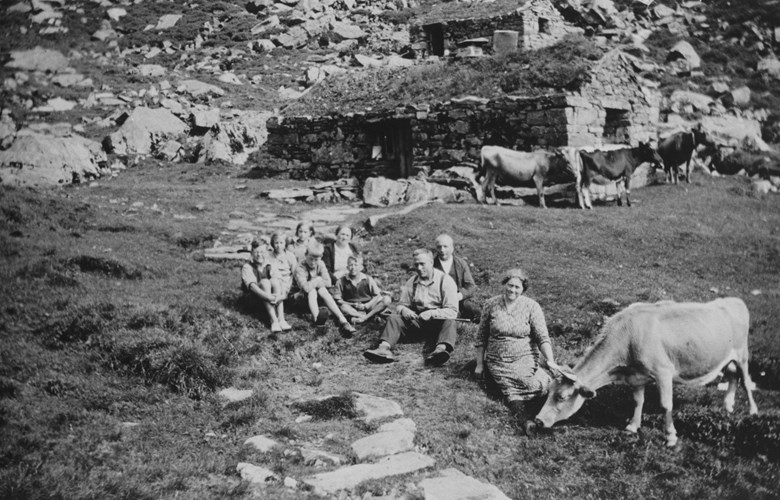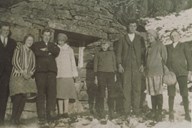Farm houses at Branden and at Skogadalen
Until the 1920s, Skogadalen was a common mountain farm for Allmenningen and Eldevika. In the 1920s, people from Eldevika built their own mountain farms further down. Allmenningen had two mountain farms, one farm used in spring and autumn in the mountain area near Branden, and a summer farm higher up in the valley of Skogadalen. Just to the west of the precipitous Branden and Kupanakken lay the road leading up to the spring farm. The cowsheds were located at Branden. There were two cowsheds, and two neighbours shared one of these. There was no place for accommodation so they had to go down the steep hillsides in the evening and up again the next morning at 7. They looked forward to coming up to Skogadalen and stay overnight there. The name Skogadalen may indicate that there was a forest there in former times ("skog" means forest).
Walls and roof of natural stone
At first, a big stone slab served as a cowshed. The farmhouses were built in the 1860s. The walls were made of natural stone up to the ridge roof. Originally the roof was made of slates, but later on the roof of the innermost part of the house was covered with birch bark. The whole roof was covered with peat, with an opening in the ceiling. In the outermost section there were traces of a fireplace. Before 1900, they used to make cheese in this room. In the area around Skogadalen there were good pastures for goats. There were also two similar farmhouses in Skogadalen, but the outer rooms were smaller. The stone slab that had been used as a cowshed was improved with a stonewall to protect against rain and wind. In addition, a shed roof of corrugated iron was placed on top to avoid the dripping from the rock.
Dangerous areas
It took from one-and-a-half to two hours to walk up to the farmhouses at Skogadalen. Usually they arrived at 18.30. It sometimes happened that the animals had not arrived so they had to go out to look for them. It might take more than an hour to find them. Frequently it took a long time to get the animals back to the farm. Sections of the animal tracks could be highly dangerous. The worst place was called Hella. The path there passed a four-five-metre-high crag. There they had to lead one cow at a time. One person stood at the top to push the animal down and one person below to catch it. At one place further up, the green grass grew out to a vertical drop. In former times, people had built stonewalls measuring hundreds of metres to prevent the animals from falling down. They used to call these walls dangerous fences, and there are still remnants of them today.
Early up in the morning
When the cows had been milked, they put the milk pails in the river to keep cool. Then the people on the mountain farm gathered in one of the houses and had evening meal together. There could be boys and girls, men and women at the farm, so all age groups had their responsibilities. When the weather was nice and warm, the cows slept outside. Then people had to get up between 5 and 5.30 to prevent the cows from leaving before they were milked. The cows were small and they did not produce much milk in summer. The work was not particularly hard. However, there was a rush in the morning. It was a good feeling to get down home to the farm with the milk before the farm people had finished their breakfast. The goats from Sørpollen often stayed for a while at Skogadalen. They liked to lie on the peat-covered roof. People who were inside could hear the goats stepping on the zink-covered opening in the ceiling.
One Sunday every summer, it was customary to have a mountain gathering at Synnevehornet. Pastries, waffles and other local delicacies were served when they had a coffee break at Skogadalen.
The area where the farms of Allmenningen and Eldevika, and the mountain pastures of Skogadalen are located, belonged to the Davik municipality up until 1 January 1965. At the boundary regulations, this area was transferred to the newly established Vågsøy municipality.


